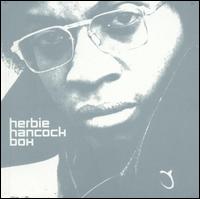

Herbie Hancock
The Herbie Hancock Box
Columbia/Legacy
Quick: try to think of an artist who has divided his/her career into several distinctly different and important creative stages. After the knee-jerk reactions of Miles Davis and David Bowie, the only other obvious choice is Herbie Hancock. Perhaps the best jazz pianist to ever vamp a chart, Hancock was also quite adept at musical reinvention.
There are his monster acoustic contributions to Davis’ mid-60’s ensembles, as well as his legendary traditional compositions of the period (which include “Cantaloupe Island,” “Maiden Voyage” and “Watermelon Man”). His electrified, Fender Rhodes-driven funk/fusion of the ‘70s. His boundary-breaking dabblings with synthesizers, turntables, world music and pop song structures in the ‘80s. Hancock’s canon is one of the most diverse in modern music, which is the intended message of the brand new, four-disc Herbie Hancock Box.
Running out and buying the latest box set or greatest hits compilation is usually a terrible way to really become acquainted with an artist. It’s the musical equivalent of reading the Cliffs Notes for The Grapes Of Wrath and wondering why it doesn’t quite have the same punch as the full novel. The same is true of this set, a somewhat flawed overview of the jazz piano great’s ‘70s and ‘80s output. Practically all of the 34 tracks on the collection are tremendous – Hancock has been one of the most consistently interesting and relevant jazz artists of the past 30 years – but the package as a whole can’t come close to replicating the incredible ambiance and personality of classic Herbie records like Headhunters, Secrets and V.S.O.P.
Columbia/Legacy organized much of the material in an effective fashion, devoting the first two discs to Hancock’s more traditional acoustic material. Disc three explores the pianist’s funk-influenced explorations. The final disc is billed as a collection of “crossover material,” and this is where the direction of the box becomes a bit dubious. With a few strange exceptions, the fourth disc focuses on the synthesizer-soaked forays that dominated Hancock’s work in the ‘80s. These cuts show that while many artists decided to throw in the towel around 1985, Hancock was at his most experimental, and far away from the ebbs and flows of the mainstream. The disc does contain “Rockit,” Hancock’s lone cross-over smash, but that’s not enough to warrant the “greatest hits” tag. Tracks like the funk masterpiece “Chameleon” and the smooth electro-fusion of “Spider” are alarmingly out of place here; their surroundings deaden the usually powerful, moody dynamics of the songs.
Even so, longtime Hancock fans will likely adore the set, which is packaged in overtly lavish fashion – the CDs rest on stacked, invisible trays, seemingly hovering in the middle of a dark, rectangular box. It’s actually quite an impressive work of art, one fitting the artist whose music the package so delicately holds. The first two discs contain the best material of the set, offering up a handful of never-before-heard treats for the Herbie junkie–there are many live performances with the supergroup VSOP that were previously only available in Japan, as well as a live cut of Freddie Hubbard’s “Red Clay” that has never before seen the light of day.
For a second, let’s forget the fact that these songs were never meant to be jumbled up and reorganized. This is a collection of the best of Hancock’s ‘70s and ‘80s material. No matter how it’s structured or packaged, nothing can change the fact that Hancock was and still is one of the greatest jazz pianists of all time. His more reserved compositions are strikingly vivacious and soulful, and his electro-fusion romps are some of the most visionary jazz pieces of recent memory, directly influencing current torchbearers like Medeski Martin and Wood and James Carter.
To truly introduce your ears to Hancock’s music, in the way he originally intended for you to hear it, pick up a copy of Headhunters and move on from there. But by no means is the Herbie Hancock Box a mistake to own. It’s a valuable look at an especially creative period in the career of a jazz/funk/fusion superstar, packed with some of the best performances of his career. And if you really need to cram for tomorrow’s jazz history mid-term, the collection is perfect.
Appeared in Issue Five of Traffic East ©2002.